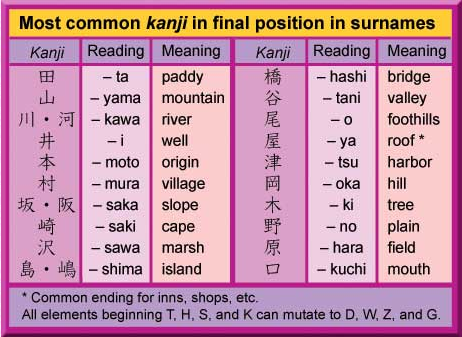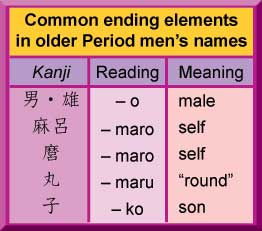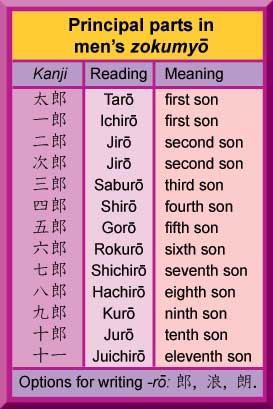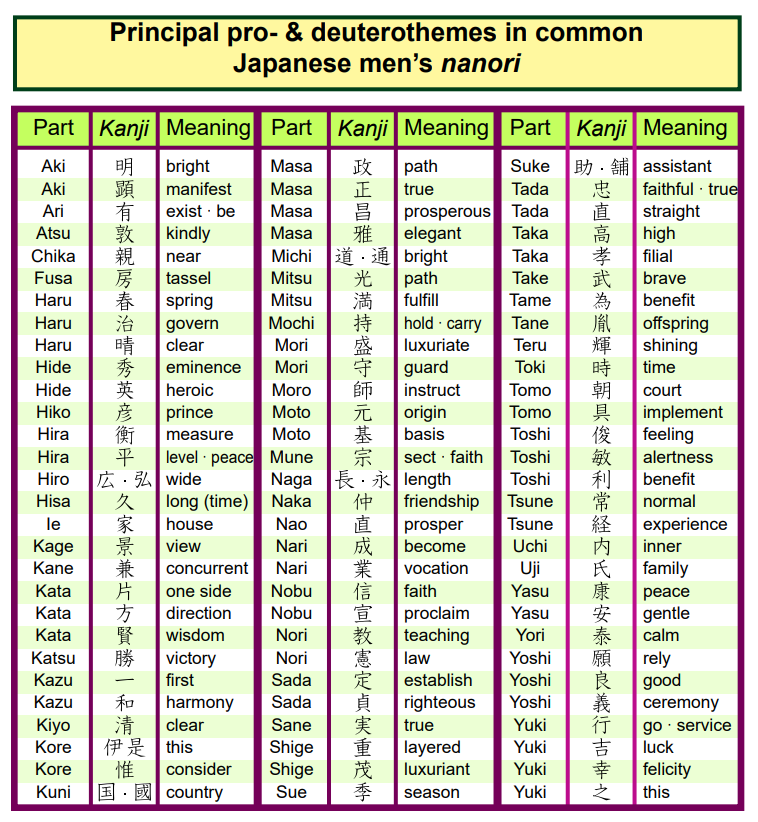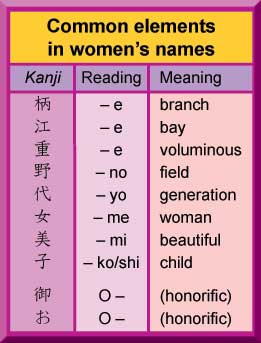Japanese Names
The first thing that needs to be remembered about Japanese names is that the surname comes first. The first Ashikaga shōgun, Takauji, was thus Ashikaga Takauji, not Takauji Ashikaga, despite the order sometimes given his name in many Western books. It is a modern oddity that even today the names of Japanese, when appearing in English, are often reversed and written in the correct order when using kanji. This is a trend slowly being reversed by magazines and newspapers in Japan, which are now starting to use the proper name order regardless of media. Some publishing houses maintain the multiple-personality disorder of keeping in original order “historical” names (i.e., people before the Meiji Restoration of 1868), and reversing to “Western order” those post-dating the Restoration. This is an unsatisfactory solution, as it does not address how to deal with era-bridging figures such as Itagaki or Saigō Takamori.
Another thing to keep in mind is that Japanese is written with what some may consider ideographs or pictographs; every element has not only a sound but a meaning. Consider the modern English names Heather, Holly, Pearl, Felicity, and Patience. These are names the Japanese can relate to; they have a meaning in our lingua franca, English. Even names like Anthony, Charles, and Edmund have meanings; it is just that they are lost on most people who don’t know the original languages of the names and their original forms. Such is not the case in Japan.
Even ancient names have meanings that can be understood if one knows the original language. They are just names, however. Just as a girl named Rose is not a flower, a man named Takeshi need not be brave, nor would a woman named O-gin actually be made of silver.
Japanese names are not random syllables strung together. Even today, where there is a habit to have girls’ names written in the kana syllabary rather than the ideogrammatic kanji, some will say “Oh, it doesn’t have a kanji,” when in point of fact, if it is a word, there is a kanji — they merely may not have thought of which of the synonymous kanji it might be.
This being said, let us take a look at names.
Structure
The structure of names changed considerably over the nearly 1,500-some years of recorded Japanese history. During the Heian and early Kamakura periods, the names of the aristocracy would be rendered as Surname no Given name. The “no” is analogous to the German “von” or the French “de” (yes, and the English “of”). Literally, the name Minamoto no Yoritomo is “Yoritomo of the Minamoto.” By the 1400s the particle was falling out of use. Technically, this naming structure reflects the use of clan names as surnames. When more and more people began adopting their own surnames (e.g., the Ashikaga, Saitō, Ichijō) rather than using ancient clan names, the use of the particle died out.
Those appointed governors of provinces would insert their title between sur- and given names. Hideyoshi, after he was made nominal governor of Chikuzen, was styled “Hashiba Chikuzen-no-kami Hideyoshi.” In SCA parameters, this should work well for landed barons of Japanese extraction; for example, the founding baron of the Trimarian barony of An Crosaire (meaning “The Crossroads” and rendered into Japanese as “Kiro”) would have been Sakura Kiro-no-kami Tetsuo. This is also one reason why I strongly feel that the use of “Naninani-no-kami” for “Lord Whatever” should be disallowed. It was and is quite clearly a landed title, even though often used only honorarily. (By the way, “naninani” is the Japanese equivalent of “whatever” or “such-and-such.”)
Later, in the Momoyama and Edo periods, many people would bear an honorary gubernatorial title; it was one way in which the court and the shogunate bestowed honors. At one time, there were half a dozen swordsmiths alone named Bizen-no-kami.
Surnames
Surnames, or (myōji), were the prerogative of the aristocracy, whether civil or military. Commoners did not bear surnames until the Meiji Restoration, though they did have bynames often used to distinguish them, which may at times be indistinguishable from surnames to the common observer (see below).
Quite a few surnames were for descriptive reasons. The founder of the Fujiwara clan, a man originally named Nakatomi no Kamako, received his new name from the field (in Japanese “hara/wara”) of wisteria (fuji) near his estate. The Ashikaga took their name from the village they ruled. The powerful Ichijō branch of the Fujiwara clan lived on Ichijō (“First Block”) in Kyoto, right next to the Imperial Palace.
Many surnames are clearly geographical or point to a physical property. Usually such descriptive names with kanji AB means B of [the] A. For example, Yama·moto (= base of the mountain), Ta·naka (= center of the paddy), Naka·da (= middle paddy), Shima·mura (= island village), Hon·da (= original paddy), Ki·no·shita (= under the tree) etc.
Let’s take a look at ta/da (= rice paddy) as an example. Quite a few specify a plant or tree nearby to delineate the exact area: Takeda (= bamboo paddy), Fujita (= wisteria paddy), Matsuda (= pine paddy), etc. Others are location specific (Shimoda, lower paddy), possessive (= Murata, village paddy), or some other descriptive (Furuta, old paddy.)
Though only samurai and the aristocracy had true surnames, bynames were in common use to help disambiguate individuals, and may be based on where they lived or worked. Yamanoue might be the guy who lived on top of the mountain. Beniya might be the man who lived in the red house. In this, the names were similar to those of the aristocracy, and (e.g., if there were a nobleman whose surname was Yamanoue) it can be confusing, though other features of the name (the use of nanori, titles, etc.) as well as context would often have provided the necessary disambiguation. In some instances, commoners may have used placename + “no” + given name to indicate that they were “of” a given place, though this is rarely written out in the record and so often difficult to distinguish.
One form of “surname” typical among commoners also occurred; the appellation. These are nicknames, like Ethelred “the Unready” or Charles “the Bald.” They are called “adana” and take the pattern of descriptive followed by (usually) the zokumyō, or (rarely) the nanori (e.g., Nossori Saburō, or Plodding Saburō; see the section on given names below for explanations on these name styles). In such cases, the man in question would be called Nossori Saburō or Saburō, but never simply Nossori. Note that this would not have been a form politely used for nobles or people of rank, even though many had nicknames. I can recall one famous instance when such a nickname became recognized as an actual surname, and that is the famous daimyō family, the Amago. The name literally means “Nun’s child,” and was taken by the founder of the house, Amago Takahisa, a grandson of Sasaki Takauji (d. 1337), because he had been orphaned at an early age and raised by a nun.
The vast majority of surnames consist of two kanji; a few names use three or more, and there is a handful of one kanji names as well. Some of the latter — though by no means all, as such native Japanese names as Katsura, Minamoto, and Kusunoki show — point to possible Chinese or Korean ancestry, where single-kanji surnames are the rule. It has been estimated that there are some 1,300 – 1,400 possible kanji used in the initial position in surnames, but only some 100 commonly occur in the final.
|
Some surnames of families active prior to 1600
|
||||
|
Abe Adachi Akabashi Akamatsu Akechi Akimoto Akita Akizuki Amago Amano Andō Aoki Aoyama Arai Arima Asai Asakura Asano Ashikaga Ashina Aso Baba Besshō Chiba Chōsokabe Daidōji Doi Endō Enomoto Enya Fujioka Fujita Fukui Fukushima Furuta Gamō Gō Gotō Hachisuka Hara Harada Hasebe Hasegawa Hatakeyama Hatano Hayashi Hijikata Hineno Hiraga Hitotsuyanagi Hōjō Honda Hondō Honjō Hori Horio |
Hoshina Hosokawa Hotta Ichibashi Ii Ikeda Ikoma Imagawa Imai Hondō Ina Inaba Inagaki Inoue Ise Ishibashi Ishida Ishidō Ishikawa Isshiki Itagaki Itakura Itami Itō Iwaki Iwakura Iwamura Iwasaki Iwashita Izumi Jō Kagae Kagami Kajiwara Kamei Kanamori Kaneko Kanō Katakura Kataoka Katō Katsura Kawabe Kawada Kawguchi Kawakami Kawamura Kikkawa Kikuchi Kimura Kinoshita Kira Kitabatake Kitagaki Kiyooka Kiyowara |
Kō Kobayakawa Koide Komatsu Konishi Kōno Kōriki Kuchiki Kuki Kumagaya Kuroda Kuroki Kusunoki Kyōgoku Maeda Makino Matsudaira Matsui Matsukura Matsumae Matsushita Matsuura Minagawa Minamoto Miura Miyabe Miyake Miyoshi Mizoguchi Mizuno Mizutani Mogami Momonoi Mori Mōri Morikawa Morioka Munakata Murakami Murata Nabeshima Nagai Nagao Nagasaki Naitō Nakagawa Nakajima Nakamura Nakatomi Nakayama Nanbu Naruse Nasu Nawa Nikaidō Nikki |
Nishi Nishina Nishio Nitta Niwa Nomura Ōba Ochi Oda Oda Ōe Ogasawara Ogawa Okabe Oku Ōkubo Okuda Okudaira Ōkuma Ōmura Ōoka Ōseki Ōshima Ōta Ōtani Ōtawara Ōtera Ōtomo Ōuchi Oyama Rokkaku Ryūzōji Saigō Saitō Sakai Sakakibara Sakuma Sakurai Sanada Sano Sasaki Satake Satō Satomi Seki Sengoku Sen Shiba Shibata Shibukawa Shimazu Shimokōbe Shinjō Shōni Sō Soejima |
Soga Sōma Sonoda Suganuma Sugawara Sugihara Suwa Suzuki Tachibana Taguchi Taira Takahashi Takayama Takeda Takenaka Tamura Tanaka Tani Tanuma Terazawa Toda Tōdō Togashi Togawa Toki Tokugawa Torii Tozawa Tsugaru Tsukushi Tsutsui Uesugi Ujie Ukita Umewaka Urakami Usami Utsunomiya Wada Wakizaka Watanabe Yagyū Yamada Yamagata Yamaguchi Yamamoto Yamana Yamane Yamanouchi Yamaoka Yanagizawa Yashiro Yonezu Yoshida Yoshii Yūki |
To see a full chart with kanji for the above names, click here.
| Surnames of kuge families | |||
| Anenokoji Asukai Aya Ayanokōji Bōjō Chikusa Fujii Fujinami Fujioji Fujitani Fujiwara Funabashi Gojō Hagiwara Hamuro Hashimoto Higashikuze Higashisanjō Higashizono Hino Hirata |
Hirohashi Honomi Hozumi Ichijō Ikejiri Irie Ishii Ishino Ishiyama Itsutsuji Jikōji Jimyōin Karahashi Karasumaru Katano Kawahire Kitanokōji Kiyooka Konoe Kujō Kushizu |
Kazan’in Mibu Mushanokōji Nagatani Nakamikado Nakanoin Nakayama Nakazono Nanba Nijō Nishiōji Nishisanjō Nishitōin Nomiya Ogura Ōhara Ōimikado Okazaki Oshinokōji Otagi Reizei |
Rokkaku Rokujō Saga Saionji Sanjō Seikanji Shigenoi Shijō Tachibana Takamatsu Takano Takaoka Takatsukasa Takeya Tokudaiji Tsuchimikado Yamamoto Yamanoi Yamashina |
Those in the SCA who deliberately choose their persona to be not of the aristocracy or samurai class need to have a locational descriptive, job title, or adana rather than a true surname, as only the upper classes had surnames.
Those desiring to simply identify themselves as being of a particular place will make use of the “no” particle. The form, given a man who, in English, would be named Jirō of Mutsu, would be Mutsu no Jirō. Remember that the rule is, the “possessor” — or larger element — comes first; in this case, the province of Mutsu.
“Surnames” of the Buddhist clergy had special rules, so those desiring to be monks or such should pick a temple to be from (e.g.; ”Enryakuji no Tosabō,” meaning Tosabō [= a monk from Tosa] of Enryaku Temple).
Reference lists of Japanese surnames and bynames
Surnames from the Sengoku Biographical Dictionary - A list of 2,227 surnames, locatives, and similar bynames found in the Sengoku Biographical Dictionary (「戦国人名事典」) with associated kanji and romanized pronunciation.
Given names: men
Up until the seventh century, many names for men of the upper classes — and this is pretty much all we have on record — often ended in ~maro or ~ko (e.g.; Muchimaro, Nakamaro, Kamako, etc.). Their names generally reflected their characteristics, or their background. In post-Nara years, naming patterns would change; partly influenced by the Chinese system, partly influenced by Japan’s own developing society. There were many different types of names, and men may have one or several of them.
Yōmyō
The most common type of name for children was the yōmyō (or dōmyō) — specifically a child’s name — which was conferred with due ceremony six days after birth. This name usually ended with the suffix ~maru, ~maro (written either with one or two kanji that have the same pronunciation), ~o, or ~waka. Occasionally, there would be similarities to the names of adults of the Nara Period.
~Maru/maro is a suffix denoting affection, and often appears on the names given swords, as well. It survives today in the naming of ships; virtually all non-military vessels in Japan have ~maru in their names. Although now usually written with the kanji for “round,” it has nothing to do with circles, despite the oft-cited implication for the hope that as the ship goes out so it shall come back. The kanji for “round” is merely synonymous with the original, more difficult, characters, in replacement for which it is today used. It is affection, pure and simple. A few famous examples of children’s names should suffice: Benkei was Oniwakamaru (= dear young goblin), and Yoshitsune was Ushiwakamaru (= dear young ox).
Another naming habit was taking positive character traits — adjectives or verbs — and making them names. Examples are names like Takeshi (= brave), Manabu (= study), and Susumu (= go forward). Those of the lower classes kept these names all their lives. What this does is point to the plebeian origins of names such as Takao, Hideo, and all of the other names making use of the noun or adjective element and the “male” suffix ~o. It also indicates that such names would not likely be acceptable for any but late-Period usage for those in upper classes.
Zokumyō
The zokumyō, (confusingly enough also called tsūshō, kemyō, or yobina) generally reflected the numerical order of birth the child had in the family. This name was taken upon the genpuku (coming of age) ceremony, and was the one by which men were commonly known to their close friends and family members. The numerical order names were often altered in some way with the addition of an auspicious adjective before it, such as Dai~ (big), Chō~ (long), Ryō~ (good), or something similar. In Heian Japan, many times the pre-numerical element was keyed to the clan from which the bearer hailed. Common, therefore, among these great families was the preface Tō~ (the Chinese reading of “fuji,” for Fujiwara), Gen~ (the Chinese reading of “Minamoto”), Hei~ (the Chinese reading of “Taira”), etc.
All things considered, this name structure produced examples like Daigorō (= big fifth son), and Chōzaburō (= long third son; the S here mutating to Z), etc. To simplify things, in the late 1500s some people started leaving off the ~rō, especially with first sons. This left names like Ryûzō (= dragon third), Genpachi (= original eighth), and Ryōichi (= good first).
Often one might bear a name like “Saburōjirō” — implying that he was the second son (jirō) of a third son (saburō). If he was the third son of a third son, his name might be “Matasaburō” — “mata” meaning “again.”
The late great actor Mifune Toshirō has a name taking the form of a classic zokumyō. Admiral Yamamoto Isoroku, of Pearl Harbor fame, was named “56th man,” although he really wasn’t, and the Mifune character in the film Sanjûrō takes his name — literally “30th man” — from his age.
Names ending in ~suke or~nosuke (actually, either element was written with a variety of kanji), ~emon, or ~zaemon, though historical-sounding and aristocratic as they are, are in large part post-Period, as they came from a habit of naming people after titles (~suke was deputy governor, and ~emon was a guard title). There were a few famous people in the Sengoku period who bore such names, but the fashion really took off in the Edo period. Today, they are generally considered quaint.
Members of the upper or privileged classes would have both a zokumyō and a nanori (see below).
Nanori
The formal adult name, taken along with the zokumyō at the genpuku ceremony, was called nanori (or jitsumei, “true name”). It usually consisted of two kanji (very, very rarely more; hardly ever one) producing a four syllable name — pronounced with the Japanese reading of the characters — which had auspicious or otherwise positive tones.
After the tenth century, the practice of the father or godfather (that is, the genpuku sponsor) granting one of the kanji in his name to the young man during the genpuku ceremony began; this is why so many of the Ashikaga shōgun have Yoshi~ as the first element in their names, and the Tokugawa family Ie~. Looking through a book of Japanese names or an encyclopedia will show many occurrences of kanji repetition in a single family. In the Minamoto, there was Yori~ and Yoshi~: Yoritomo, Yorinobu, Yorimasa, etc.; Yoshitsune, Yoshiie, Yoshichika, Yoshinaka, etc. The Oda clan used Nobu~ frequently, and the Hōjō regents used Toki~. (This is one reason the SCA’s Laurel Sovereign of Arms may wish to consider allowing the names of exalted families but restrict any using given name elements common to those clans.)
The order of kanji placement could have gone either way, but one given a kanji which is first in his godfather’s name seldom puts it second in his; one could, however, be given the second kanji instead. This would have been no slight, either; different families followed different traditions, and different kanji have different meanings. Yasunobu and Nobuyasu, written with the same two kanji, merely transposed, are both perfectly acceptable names.
The chart below provides the principal kanji for the most common elements used in nanori. As many name elements have different meanings, depending on the kanji used, it is difficult to provide a complete list of choices. I have only provided a few of the most common. The chart will enable you to produce thousands of combinations of nanori.
Keep in mind that the “meanings” are only cursory at best — few name kanji parse one-to-one with an English concept, especially when that kanji is being used as a name. For example, most words dealing with “law” relate to Buddhist concepts of order and so forth; and the second kanji for “Toshi” below can be roughly translated as “agile, alert”, etc., but it pehaps most closely resembles the English concept “on the ball.”
For a printer-friendly PDF version of the nanori chart (you don’t need Japanese fonts for this), click here. The file is large (about 230k) but it’s clear and you can print it and use it for your name documentation.
Nanori consisting of a single kanji are either read with the Chinese pronunciation and sounding monosyllabic to Western ears though in actuality two syllables (e.g.; actor Matsudaira Ken); or the Japanese pronunciation utilizing verbal or adjectival forms and are tri-syllabic (e.g.; Takeshi, brave; Tadashi, correct; Shigeru, luxuriant). On the whole, such names seem more modern, as they are more common today than in days past.
Azana
Given names of two kanji, when read in the Chinese fashion (with Japanese version of the Chinese pronunciation), are more formal-sounding, and lend an academic, cultured (and, yes, often clerical) feel to the name. Such names are called azana. Often they are usually indicative of artists, performers, or men of letters. They are not unlike a medieval man named Karl living in Frankfurt using the name Carolus.
Putting it all together
Taking Yoshitsune as our example, his myōji was Minamoto, his yōmyō was Ushiwakamaru, his zokumyō Kurō, his nanori Yoshitsune, and an azana would be Gikei. All this for a name which should be registered in the SCA as Minamoto no Kurō Yoshitsune.
The chart above provides enough fodder for making several hundred names in Japanese. Another way is to look through a name encyclopedia (the most accessible in English is probably P.G. O’Neill’s Japanese Names, finally available in paperback from Weatherhill, or Lady Solveig Thorardottir’s Jinmei chimei techō, a catalogue of names). The only problem here is that unless you speak Japanese, there is often no telling what the names mean or if they are Period or acceptable; O’Neill and others suffer greatly for this, although Jinmei chimei techō breaks down names by the meaning of the principal kanji element and provides a date for at least one occurrence for each name.
Given names: women
A warning on women’s names needs to be given before anything else is done.
Most of the “names” of women known in early Japan are not the actual names of the women in question. Sei Shōnagon, for example, the author of Makura no Sōshi (The Pillow Book) and other writings, is known by the Chinese pronunciation of the first kanji in her family’s name (Kiyowara) and a court-title sobriquet. Likewise, the true name of Murasaki Shikibu, author of the Tale of Genji, is unknown. The latter seems to have been called Tō no Shikibu in earlier sources; the “Tō” is the first character from the name “Fujiwara,” into a cadet branch of which she had been born; the “Shikibu” comes from the title of an office held by her father and brother; the “Murasaki” was a nickname given her owing to the lead female character in her book, Genji Monogatari (The Tale of Genji).
It should be remembered that few women’s names of the Heian Period have come down to us save those of empresses or the like; other women’s names never made it into the early genealogical charts.
Women did not change their names as did the men upon reaching a certain age; they kept theirs for life. The only likely time a woman would change it would be if, say, she became a nun. Their names were usually written in kana rather than kanji; the latter were generally reserved for men, though there is nothing wrong with using them for a woman’s name. Kana were (and still are) just assumed to be more feminine.
Although it is often assumed that all Japanese women’s names end in ~ko, this is not the case. Historically, very few women had the ~ko ending on their names. (It was originally a male naming element, in fact, though this seems to have mostly been the case in the early Nara era and prior.) Women of the highest ranks had it from the Heian Period onwards, but rarely. As late as the 1880s, only three percent of Japanese women had ~ko names. By the 1930s, for various reasons, it was around eighty percent. For Period usage, we in the SCA use it far too much.
Almost completely neglected are other ending elements (~e and ~yo) or names with no suffix at all. (Women with ~ko would in fact often use their names without the ~ko in Period, recognizing it as an honorable suffix; this usage is no longer the case, however.) In the court, names ending in ~ko were actually apparently often pronounced in the Chinese fashion (~shi), so the name of the imperial consort commonly read “Sadako” today was in the court known as “Teishi.”
An interesting note is that names of more than two syllables were never finished off with a ~ko suffix; it was deemed simply too much name. Women were usually given two syllable names as well, without the suffix, although in the court three syllable names (no suffix) were not uncommon.
Frequently the names of plants, things from the arts, seasonal elements, and other “feminine” things were taken for use as women’s names. For example, in the film Ran, the Lady Macbeth stand-in is Kaede (maple). The 1500s saw the introduction of the honorific prefix O~, thus names like O-matsu (pine), O-gin (silver; final n being a syllable in Japanese), O-haru (spring), etc. Modern naming practice would render that last as “Haruko.”
Common second-characters for women’s names were ~e (branch), ~e (bay), ~e (a great amount of ~), ~no (plain, field) and ~yo (age, generation), and even the lowly ~me (woman).
Women of noble families — take O-matsu, daughter of Takeda Shingen, for example — when addressed, would typically be called Matsu-hime. The “-hime” means essentially princess (and indeed is an address for one), but in rule of use it functions similarly to the SCA use of “Lady.” She would generally not be called “O-matsu-hime,” as that might be considered an incongruous and redundant combination of honorifics.
Taken names
Japanese seem inordinately fond of pseudonyms.
While it is not uncommon for an entertainer in the West to take a new name upon mounting the stage, it is an extreme rarity for a Japanese not to do so. Just about every field of endeavor has alternate naming traditions.
Men interested in clerical personae or the Buddhist militant clergy should note that that up until the 1500s, monks generally took as their “given name” the region they were born, and added to it the suffix ~bō (= or monk), thereby very Buddhistically severing their ties; they no longer had names. Musashibō Benkei was such; he came from the Musashi region (as did a certain famous swordsman several centuries later) and his chosen name was Benkei. Alternatively, they could add a Chinese-pronounced name called a hōmyō (= Dharma name) related to Buddhist doctrine or teaching. The lay nobility kept their family names, and merely adopted Chinese-pronounced hōmyō (e.g.; Takeda Shingen, whose original name was Harunobu, and Hōjō Sōun, whose was Nagauji).
Buddhist names may be followed by the epithet nyūdō (”one who has entered into the way”). An example would be Raizen Nyūdō; the usage is really not too dissimilar to “Brother So-and-so” or “Father So-and-so.” Nyūdō, unlike traditional monastic clergy, were “lay clergy” — though they lived a monastic life (at least in theory), they typically had their own homes and lives. For this reason, “nyūdō” is often translated as “lay monk.” Shingen and Kenshin were both Nyūdō, as was Taira no Kiyomori, the patriarch of the Taira clan at the start of the Genpei War. The concept of “lay monk” was strictly male: women who became monastics (”ama” — nun) simply became monastics, regardless of their actual living conditions.
Names taken by artists and members of the literati were collectively called azana. Warriors took gō, painters took gamyō, haiku artists took haimyō, entertainers geimyō, etc. The implication behind the new name is that the artist belongs to a higher life. (Of course, there were also instances when the artistic career would be potentially damaging to one’s reputation if the true name were known.) The artist would keep his regular name, at any rate, but all his work would be signed with his art name. (This, of course, would play hell in the SCA in establishing a reputation of an artisan or craftsman if you were involved in other areas as well, unless you sign everything in kanji, so it is the same person, same name; only the reading is different.) These names would often end with such suffices as ~dō (hall), ~ka (retreat), ~tei (pavilion), ~kaku (tall building), etc.
Many followers of the Pure Land Sect, or other followers of Amida Buddha, showed their attachment to Amida by appending ~a or ~ami to a single kanji read in the Chinese style in either their given or surname (e.g.; the famed playwright Zeami, and the artist family of Hon’ami).

